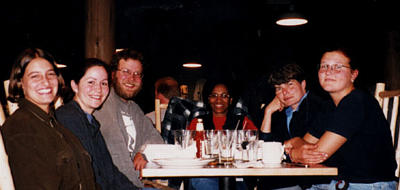24 July, 1998
Myrtle Brijbasi
TEA/Alaska - 98
Journal Entry 15 - July 24, 1998
Alaska SeaLife Center, Ak
As we looked into the pool this morning we noticed that there were
no fish in the pool, and that there was blood on the edge of the pool.
Assumption? fish caught and eaten. The day is a bright sunny day and the
otters are showing signs of playfulness. Cabin is having a lot of fun with
the blankets. He climbed up into the tote that has the clean dry blankets
and pulls them out one by one. Obviously the tote became unbalanced so the
entire load of blankets fell on him. Though he scampered away at first, he
returned to pull out the blankets one by one. Today Susanne and Dr.
Ben-David are feeding the otters while Noa and Olav clean the kennels, dens
and outdoor lab. Elisa and I will observe and record behaviors.
Naked is sedated to administer some medication -zantac. This is to
trace any internal bleeding since his blood count is rising slowly. At the
last bleeding, Dr. Ben-David had expected a higher blood count.
The otters are exhibiting extensive multi-grooming, and much
playful behaviors.
There were no aggressive behaviors.
Later that afternoon, a fishing trip out on Resurrection Bay was
planned. It was a fun trip even though a lot of fish were not caught. The
water was somewhat "choppy" going and coming, and Dr. Ben-David maneuvered
the boat most skillfully. She was certainly in her element since this is
one of the activities she enjoys immensely. Some rock fish were caught for
study at the SeaLife Center, and several gravid ones that were caught were
released back into the bay. A ling cod was caught and immediately released
back into the water, but the graylings were kept and brought back for the
otters. My job was to aerate the water in the tote that had the fish which
were caught and try as hard as possible to maintain the temperature similar
to that of the bay.
We returned to the center earlier than planned because we wanted to
keep the fish alive. The fish were placed in the pool with the otters for
them to have a feast, and at the same time to encourage diving and foraging
success.
We also checked the fish tanks holding the salmon. They did not eat
the shrimp nor the stripped herring. The salmon were gravid and were
behaving as though they were in their natural habitat - starving in
preparation to spawn and then die utilizing the proteins from their own
bodies.
Well, all good things must come to an end. Just imagine, tomorrow
is our last official day working on this research project. The
three-and-a-half weeks just flew by. As the saying goes - Time flies when
you're having fun. This project was fun as well as an enlightening
experience. It was an excellent journey into the field of behavioral
ecology and physiology. All of us became attached to the otters and were
very excited when they behaved in certain ways, especially if these
behaviors were instinctive. We waited patiently to observe anticipated
behaviors and also reacted to the predicted behaviors with great
excitement. It is difficult to suddenly withdraw ourselves from this
project in which we were totally immersed for the past few weeks. However,
all is not lost. We will be in constant communication via web site and
email with Dr. Ben-David regarding the remaining phases of the research. I
have learned a great deal of information from this project and I can't wait
to share all of it with my students, colleagues, friends and relatives.
Here ends another day in the life of the river otters. Tomorrow I
hope that all of the otters will come out and roam around in the outdoor
lab so that I can see them one more time before I leave for home. These
otters are just adorable.

River otter habitat in Resurrection Bay, near where we were fishing.

Dinner with the 'otter crew' (L-R: Noa, Elisa, Olav, Myrtle, Merav, and Susanne).
Contact the TEA in the field at
.
If you cannot connect through your browser, copy the
TEA's e-mail address in the "To:" line of
your favorite e-mail package.
|
